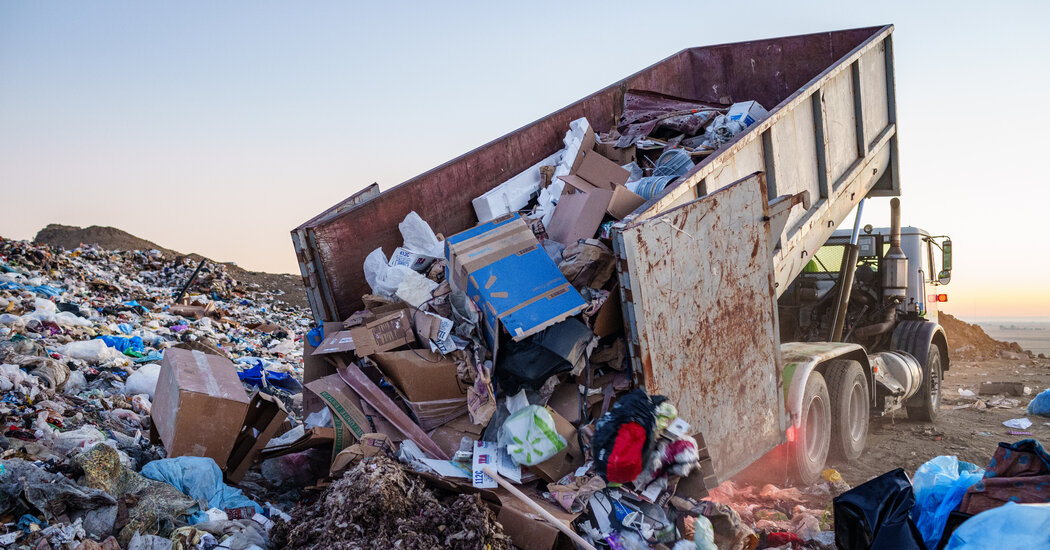They’re vast expanses that can be as big as towns: open landfills where household waste ends up, whether it’s vegetable scraps or old appliances.
These landfills also belch methane, a powerful, planet-warming gas, on average at almost three times the rate reported to federal regulators, according to a study published Thursday in the journal Science.
The study measured methane emissions at about 20 percent of about 1,200 large, operating landfills in the United States. It adds to a growing body of evidence that landfills are a significant driver of climate change, said Riley Duren, founder of the public-private partnership Carbon Mapper, who took part in the study.
“We’ve largely been in the dark, as a society, about actual emissions from landfills,” said Mr. Duren, a former NASA engineer and scientist. “This study pinpoints the gaps.”
Methane emissions from oil and gas production, as well as from livestock, have come under increasing scrutiny in recent years. Like carbon dioxide the main greenhouse gas that’s warming the world, methane acts like a blanket in the sky, trapping the sun’s heat.
And though methane lasts for a shorter time in the atmosphere than carbon dioxide, it is more potent. Its warming effect is more than 80 times as powerful as the same amount of carbon dioxide over a 20-year period.
The Environmental Protection Agency estimates that landfills are the third largest source of human-caused methane emissions in the United States, emitting as much greenhouse gas as 23 million gasoline cars driven for a year. Organic waste like food scraps can emit copious amounts of methane when they decompose.
But those estimates have been largely based on computer modeling, rather than direct measurements. A big reason: It can be difficult and even dangerous for workers with methane “sniffers” to measure emissions on-site, walking up steep slopes or near active dump sites.
For the new study, scientists gathered data from airplane flyovers using a technology called imaging spectrometers designed to measure concentrations of methane in the air. Between 2018 and 2022, they flew planes over 250 sites across 18 states, about 20 percent of the nation’s open landfills.
At more than half the landfills they surveyed, researchers detected emissions hot spots, or sizable methane plumes that sometimes lasted months or years.
That suggested something had gone awry at the site, like a big leak of trapped methane from layers of long-buried, decomposing trash, the researchers said.
“You can sometimes get decades of trash that’s sitting under the landfill,” said Daniel H. Cusworth, a climate scientist at Carbon Mapper and the University of Arizona, who led the study. “We call it a garbage lasagna.”
Many landfills are fitted with specialized wells and pipes that collect the methane gas that seeps out of rotting garbage in order to either burn it off or sometimes to use it to generate electricity or heat. But those wells and pipes can leak.
The researchers said pinpointing leaks doesn’t just help scientists get a better picture of emissions, it also helps landfill operators fix leaks. Keeping more waste out of the landfill, for example by composting food scraps, is another fix.
Overseas, the picture can be less clear, particularly in countries where landfills aren’t strictly regulated. Previous surveys using satellite technology have estimated that globally, landfill methane makes up nearly 20 percent of human-linked methane emissions.
“The waste sector clearly is going to be a critical part of society’s ambition to slash methane emissions,” said Mr. Duren of Carbon Mapper. “We’re not going to meet the global methane pledge targets just by slashing oil and gas emissions.”
A growing constellation of methane-detecting satellites could provide a fuller picture. Last month, another nonprofit, the Environmental Defense Fund, launched MethaneSat, a satellite dedicated to tracking methane emissions around the world.
Carbon Mapper, with partners including NASA’s Jet Propulsion Laboratory, Rocky Mountain Institute, and the University of Arizona, intends to launch the first of its own methane-tracking satellites later this year.



